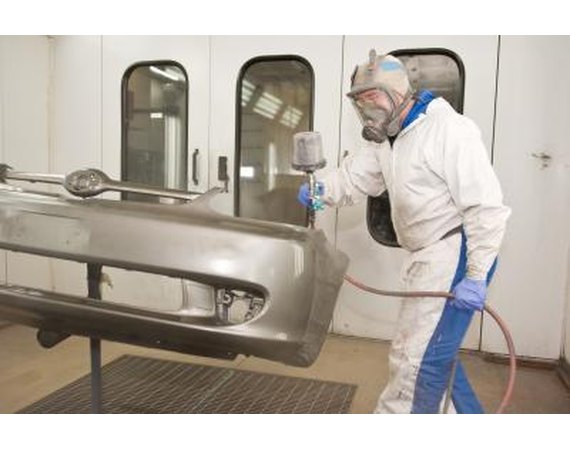
The use of lacquer or enamel paint, typically for automotive jobs, depends on several factors that every painter should know. Although both types of paints can be used with a spray gun, these paint types have several differences, such as drying and curing time. Both types have several advantages and disadvantages, and the ultimate deciding point on what type to use really depends on the type of job.
Application
Lacquer, being both a more volatile material and with a more fluid consistency, should be sprayed at air pressures of about 45 lbs. to 50 lbs. on automobiles. Holding the spray gun about six or eight inches away from the painting surface is necessary. Enamel is less fluid and less volatile than lacquer, requiring larger gun nozzle-to-surface distances of eight to 12 inches. Maintaining the distance is essential for both paint types. However, the likelihood of sagging, heavy, or wet areas is relatively greater with enamel than lacquer paints. If the job requires an almost seamless paint job, applying lacquer paint can be better.
Thinning
Lacquer paint is thinned using a one-and-a-half unit to two-unit proportion between thinner and lacquer. Enamel is thinned with a one unit to five units of thinner to enamel proportion. More solid elements in one enamel coat make it parallel to several lacquer coats. Thinning enamels can be performed using lacquer thinner, but mineral, white or paint thinner which is a typical enamel reducing agent, cannot be used to thin lacquer.
Drying and Curing
Once surface application is accomplished, enamel paints dry and cure more quickly. This is due to the rapid chemical reaction that the vehicle solvent in enamel undergoes as it evaporates. When drying and curing develop, enamel solvent becomes harder and more insoluble. Using the same solvent to lift away enamel that has undergone full curing is normally impossible. Lacquer does not undergo curing as it merely dries, so polishing can commence quickly to acquire a glossy finish. No chemical reaction occurs when the solvent gets dispersed into the air.
Ease of Use and Wear Resistance
Regarded as soft and not long lasting, lacquer paint is not resilient against deterioration caused by ultraviolet rays or chemicals. Although it is a fast-drying compound, thinning is necessary to facilitate spraying. About three or four coats are required, and due to the easy solubility of underlying coats, removing imperfections by repainting can be much simpler. Enamel paints are not so easily applied, especially when painting a vehicle. Painting with enamel requires more finishing work to acquire the desired clear topcoat. One or two coats works fine without clear coat application or rubbing out, but the resulting hard shell finish is typically satisfactory.
0 comments:
Post a Comment